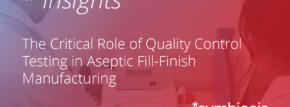By Dr Katherine Reid and Lesley Lumsden, MSc
Novel biologic therapies have shown success across a wide range of disease areas, particularly for the treatment of oncological indications. This success continues with the US Food and Drug Administration (FDA) giving the green light to 7 novel anti-cancer drugs in 2022 including a fibroblast growth factor receptor (FGFR) inhibitor, peptide receptor radionuclide therapy (PRRT) and a bispecific gp100xCD3 antibody.
To execute the development of a marketable, parenterally administered oncology therapeutic, fill-finish is an essential stage of product development. Sometimes underestimated, this vital process ensures the sterility of an anti-cancer drug product while it’s filled and sealed in its final container ready to be administered to a patient. The challenges faced by CMOs can be broadly characterised as:
Understanding Each Drug Product Formulation
It’s imperative to work closely with clients to fully understand the unique physical and chemical characteristics (and behaviours) of drug product formulations which can then be translated into a reproducible, reliable, commercial process for fill-finish. Given the sophisticated formulations now being brought to clinical trials, a one-size-fits-all approach will likely not suffice. With a wide range of molecular properties to balance, each batch of drug product must be assessed to ascertain the appropriate manufacturing conditions including the parameters of filtration systems such as tubing shore hardness, filter surface area, membrane type etc, as well as the filling needle size and pump flow rate.
Symbiosis is equipped to develop bespoke rigs to accommodate the nuances of complex formulations. For example, due to their molecular size, some viral vectors cannot pass through a 0.2µm pore and therefore cannot be subject to typical sterile filtration stages to reduce the potential bioburden prior to filling. Consequently, viral vectors can arrive at a CMO already sterile. Unlike other modalities that go through each sterilisation process on-site, fill-finish processes must be adapted by designing a completely aseptic process from pooling through to filling to ensure that the sterile drug product maintains its integrity, preventing contamination and achieving timely filling.
Preserving Drug Product
As drug supply chains are becoming ever more complex, drug product loss due to the manufacturing process can result in exorbitant costs if left unmitigated. Complex procurement chains for both APIs and excipients can also result in lengthy delays to drug development timelines should additional volumes be required. Therefore, it’s of the utmost importance that every measure is taken to preserve drug substance at each step of the fill-finish process.
To maximise product viability and reduce risk of degradation during transport, drug substances are frequently received by a CMO in a frozen state and require thawing prior to filling and finishing. However, parameters of freeze/thaw must be informed by attributes such as protein concentration, pH, salt concentration and balanced with excipient concentrations, characteristics and stability of the product. If the conditions of thawing are not known prior to fill-finish, it’s typical that scaled models for freezing/thawing are performed to validate this stage in partnership with your CMO.
Furthermore, where lyophilisation of a drug product is required, and a client hasn’t developed optimal lyophilisation cycles, it’s important to spend time establishing appropriate phases to avoid melt-back and any loss of materials as a result of incomplete lyophilisation . It’s therefore crucially important to contact your CMO in advance of a project start date to ascertain the appropriate volumes of drug products/excipients, considering testing, testing qualifications, process simulations and engineering runs necessary to align with regulatory guidelines.
Containment of Potent Cytotoxics
Effective oncolytic drugs typically necessitate high-potency formulations with cytotoxic or genotoxic properties. Therefore, the containment of the cytotoxic payload is crucial for the safety of operators, patients, facilities and the environment . Moreover, novel formulations can contain solvent(s), potentially resulting in product contact material incompatibilities and creating harmful waste products at the lyophilisation stage which must be handled with appropriate containment and control.
Managing highly toxic payloads throughout the fill-finish process is facilitated through a range of stringent regulatory conditions for product-sharing facilities which are to be met by every operator but are supported using single-use components. CMOs can confidently mitigate the risk of cross-contamination from persistent compounds such as peptides using disposables. This prevents the need to clean stainless steel or glass equipment and validate each clean, streamlining manufacturing stages.
Due to the complexities of potent, innovative drug formulations, a highly knowledgeable and skilled team of operators, project managers and technical staff are critical to the success of a therapeutic program. Selecting a trusted and capable CMO (with an appropriate high potency compound categorisation system, tailored for the facility of use) can overcome many of the challenges of working with highly concentrated formulations.
Conclusion
With more sophisticated, specific formulations reaching clinics, novel biologic therapies have the potential to change the lives of patients with unmet clinical needs. Aseptic manufacturing acts as the final step before administration to patients, to ensure that drug products are free from contamination but to do so, CMOs must work closely with clients. Careful consideration must be given to the unique characteristics of each formulation requiring cytotoxics to be manufactured under stringent containment, whilst preserving precious drug products, throughout the fill-finish process
About Symbiosis
Should you require aseptic manufacturing of parenterally administered therapeutics, the Symbiosis team are on hand to provide rapid access to accelerate your drug product. Our experts are equipped to assist from process design, utilising the latest single-use technology to filter selection, visual inspection and qualified person release. Our wealth of experience in the formulation and fill finish of products utilising several approaches including protein/antibody conjugates, lipid conjugates, nanoparticles, and viral vectors. Get in touch to discuss your latest drug product program.



